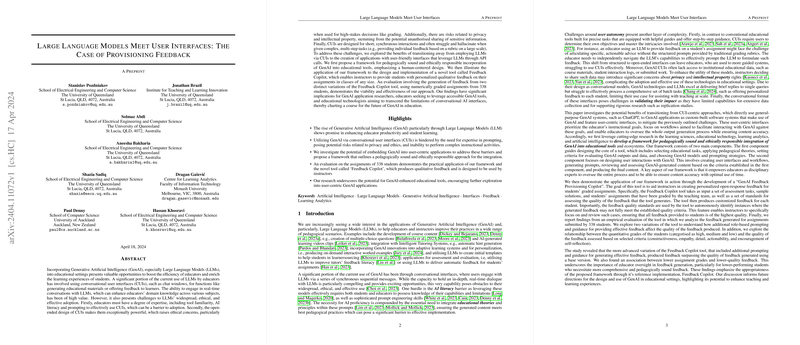LLMs Meet User Interfaces: The Case of Provisional Feedback
Introduction to the Paper
The paper details an exploration into the use of Generative Artificial Intelligence (GenAI) applications in educational environments, specifically focusing on how LLMs can be integrated within user interfaces to enhance educational tasks. It introduces a novel framework for the design and application of these technologies as standalone, user-centered systems rather than relying purely on conversational user interfaces (CUIs). The paper bases its observations on previous challenges found in standard CUI applications of GenAI, proposing a two-component framework to refine educational technology design and interaction. A practical application, the "GenAI Feedback Provisioning Copilot," is developed utilizing this framework, aimed at aiding instructors in generating high-quality personalized feedback for student assignments.
Key Challenges and Proposed Solutions
The paper identifies several enduring challenges in the existing deployment of LLMs through CUIs, including:
- AI literacy barriers necessitating significant prompt engineering skills from users.
- Limited user autonomy and guidance, complicating user engagement with open-ended interfaces.
- Restricted access to institutional data, raising privacy and intellectual property concerns.
- The difficulty in managing batch tasks effectively due to the conversational nature of most GenAI applications.
To tackle these challenges, the paper introduces a structured framework emphasizing:
- Designing Core Educational Tools: Selection of educational tasks, integration of pedagogical theories, and implementation criteria for evaluating GenAI outputs and data.
- Designing User Interactions: Developing user interfaces and workflows, handling prompt generation, and facilitating content review to ensure accuracy and pedagogical soundness.
Implementation and Insights from the Feedback Copilot
The "GenAI Feedback Provisioning Copilot" serves as a reference implementation for the proposed framework. It aims to assist educators in crafting personalized feedback for students' graded assignments. This tool generates feedback based on a set of predetermined standards for quality and provides the option for educators to review cases where the feedback may not meet quality standards.
The paper employs the Feedback Copilot in an experimental setup involving 338 students' assignments. Findings suggest that the advanced version of the tool, which includes additional prompting and guidance, produces better-quality feedback compared to its base version. Moreover, feedback quality was found to correlate with student performance; lower-performing students received feedback of lower quality, indicating an essential area for closer educator involvement.
Theoretical and Practical Implications
The paper contributes significantly to the discourse on integrating AI in education by addressing both practical and theoretical aspects. Practically, it provides a blueprint for constructing GenAI applications that are more aligned with educational frameworks and sensitive to the challenges educators face. Theoretically, it pushes forward the conversation on how LLMs can be systematically evaluated within educational settings to ensure they not only adhere to pedagogical standards but also genuinely augment the teaching and learning experience.
Future Directions in AI and Education
Looking forward, the paper speculates on several advancements:
- Improved interfaces for GenAI applications that offer more intuitive and responsive user guidance.
- Enhanced integration of institutional data within GenAI applications while managing privacy and ethical considerations more robustly.
- Deeper explorations into tailored GenAI applications across different educational contexts and subjects.
This comprehensive paper enriches our understanding of the intersection between LLMs and user interfaces within an educational context and sets the stage for subsequent innovations and refinements in this promising field.
